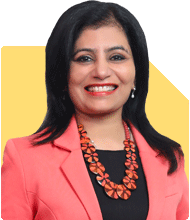Stuck in a Rut: Can a Malnourished Computer Science Graduate Overcome Academic Challenges and Find a Job?
Archana Deshpande | Answer |Ask -Follow
Image Coach, Soft Skills Trainer - Answered on Aug 22, 2024
She has been working with individuals and corporate organisations for more than 10 years during which she has helped professionals and students improve their soft skills, build confidence and enhance self-esteem.
An engineer from the PDA College of Engineering, Gulbarga, Archana had a successful career at Reliance Communications. But she has always been interested in teaching and training people. So she pursued a postgraduate diploma in teacher’s training at Pune’s Symbiosis Institute of Management Studies followed by teaching assignments in schools at Visakhapatnam and Mumbai.
Archana also holds an international certificate in image consulting and soft skills training from the Image Consulting Business Institute, Mumbai.... more

I graduated in 2022 with computer science degree from mediocre college where teachers can't themselves speak in English but teach us through only black board learning , rote learning and notes, ask predictable and same set of questions which were asked in the last year exam because of COVID disruption and online learning I can't concentrate on my study and even though I tried to learn programming through courses, but I couldn't become proficient in them and i can't get a job because through campus placement. I was malnourished and stunted child and I have read that malnutrition and stunting limits congitive intelligence and leads to poor learning ability , learning capacity and unfortunately, I did not get quality education in school as my family is not comfortably well off so I attended unrecognised school upto class 8. I only managed to clear entrance exam of college through rote learning and procedural knowledge of mathematics. I am stunted adult (5.ft) and weak vocal cords so I dread giving presentation. Is there any hope for me . I try to take government job exam but my memory took a hit because of COVID. I don't know what to do and how to get a job and what to learn. I can't retain most of information. Am I helpless? I got corona degree : Passed Without Exam: Will ‘Corona Degree’ Hold Weight In Future?
You seem to me like a person who is capable of doing much more... look at you... the way you have written this whole question so clearly, explaining your predicaments in very good English, is a proof of your capability.
Now young adult... this is what I want from you-
1. you have come this far...congratulations....bad school you said, malnourished you said, COVID degree you said...I just want you to stop complaining
2. you are really good, resilient....in spite of all the circumstances you narrated so far, none of them were in your control, yet here you are A Computer Science graduate, can you not see that you are good, you rise even when life has not been so fair. Believe in yourself my friend
3. you take heart in what Buddha said, "you are what you think", start by changing your vocabulary, start thinking positively about everything ... 5 ft is good height, check how tall was Napoleon Bonaparte.... you are as tall as you think. Change what you can, accept what you can't change, and be smart enough to know the difference. Pls do not cry about what you can't change- your height, corona, they are all not in your control at all... accept and move forward pls
4.if you think Corona degree is not good enough, then explore other options, see if you can earn another certificate course that will help you in your job search... this time choose wisely
5. ask yourself, "what is that I want my life to look like" and start working towards it, one step at a time.
6. for focus and memory to improve I totally rely on Yoga and Meditation, it can totally help you too...give it a shot
With all my suggestions above, what I am trying to tell you is that, " you are a very smart kid", start looking for solutions now, enough of crying over spilt milk!!
All the best... take all actions today, with one leg in the future!! God created you, love your self!!
You may like to see similar questions and answers below
Nayagam P P |10859 Answers |Ask -Follow
Career Counsellor - Answered on Oct 02, 2024
Ramalingam Kalirajan |10908 Answers |Ask -Follow
Mutual Funds, Financial Planning Expert - Answered on Dec 20, 2025
Ramalingam Kalirajan |10908 Answers |Ask -Follow
Mutual Funds, Financial Planning Expert - Answered on Dec 20, 2025
Naveenn Kummar |237 Answers |Ask -Follow
Financial Planner, MF, Insurance Expert - Answered on Dec 20, 2025
Ramalingam Kalirajan |10908 Answers |Ask -Follow
Mutual Funds, Financial Planning Expert - Answered on Dec 19, 2025
Nayagam P P |10859 Answers |Ask -Follow
Career Counsellor - Answered on Dec 19, 2025
Ramalingam Kalirajan |10908 Answers |Ask -Follow
Mutual Funds, Financial Planning Expert - Answered on Dec 19, 2025
Ramalingam Kalirajan |10908 Answers |Ask -Follow
Mutual Funds, Financial Planning Expert - Answered on Dec 19, 2025
Ramalingam Kalirajan |10908 Answers |Ask -Follow
Mutual Funds, Financial Planning Expert - Answered on Dec 19, 2025
Radheshyam Zanwar |6751 Answers |Ask -Follow
MHT-CET, IIT-JEE, NEET-UG Expert - Answered on Dec 19, 2025
Radheshyam Zanwar |6751 Answers |Ask -Follow
MHT-CET, IIT-JEE, NEET-UG Expert - Answered on Dec 19, 2025






















